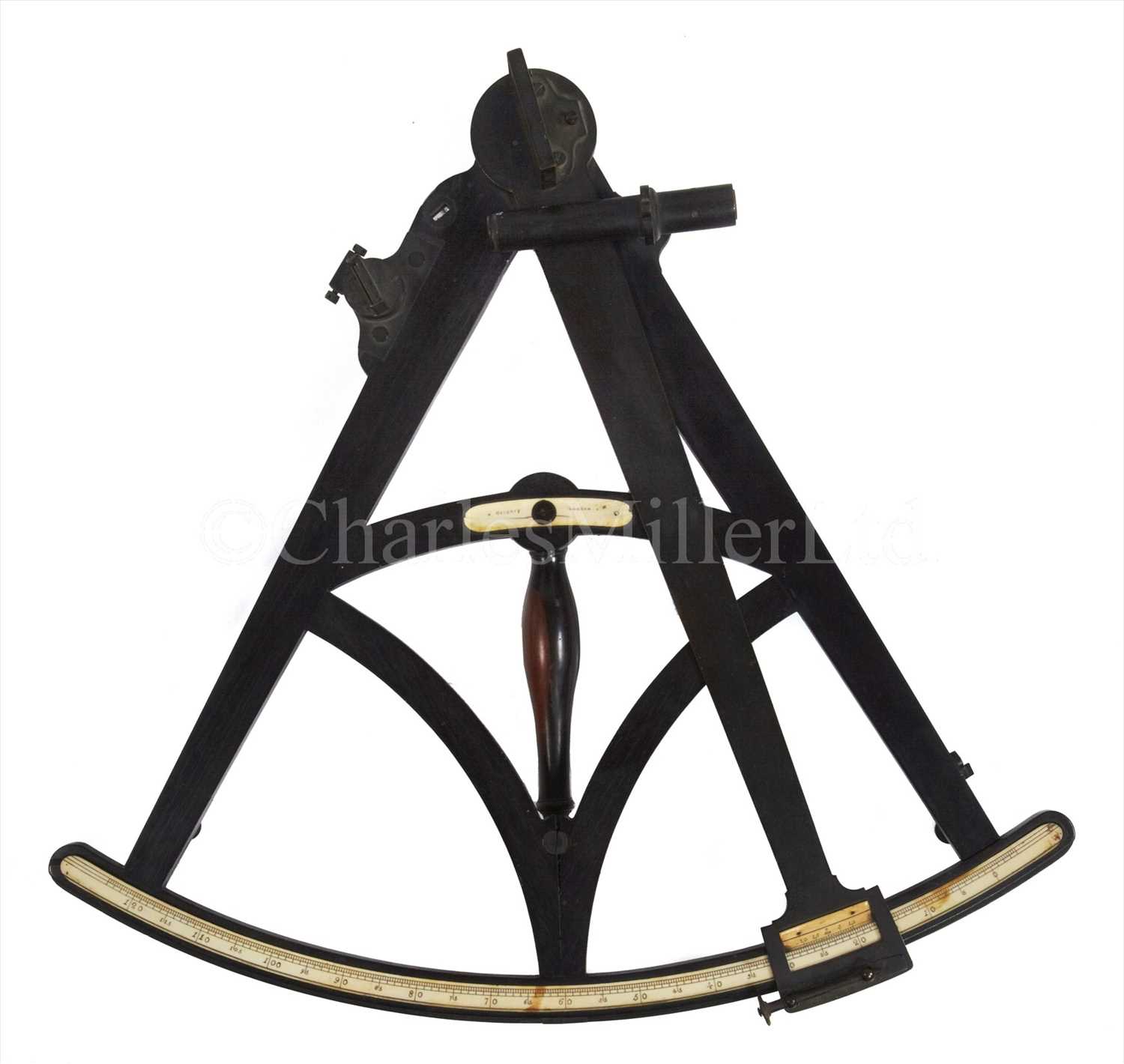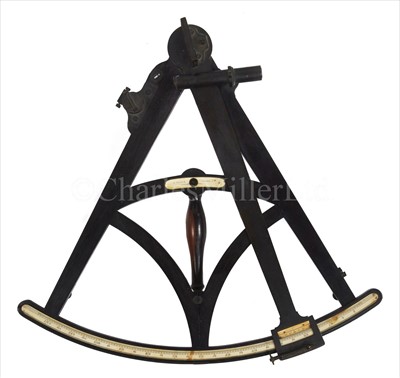20th Apr, 2011 12:00
Maritime and Scientific Models, Instruments & Art (Princess)
240
[M] A RARE 18IN. RADIUS VERNIER SEXTANT BY...
A RARE 18IN. RADIUS VERNIER SEXTANT BY GREGORY, LONDON, CIRCA 1775
with ebony 'V' frame, ivory scale divided to 125°, brass index arm, Vernier with centralised '0', signed on the cross bar GREGORY LONDON, sighting tube, index and horizon mirrors, two pin feet and rosewood handle (horizon mirror silvering worn, lacking shades and one pin foot) -- 19 x 20½in. (48.2 x 52cm.)
Probably Henry Gregory I who worked between 1744 and 1782 - the firm became Gregory & Son in 1776 and then formed partnerships with former apprentices including Gabriel Wright and William Gilbert. This sextant was probably an attempt to break into new markets, although with its ebony frame and huge radius, it still gives every appearance of an octant. The ability to divide finer scales accurately, thus allowing the frame to shrink, was already then in hand, with Jesse Ramsden publishing his 'description' for a dividing engine in 1777.
Literature: Mözer Bryuns, W.F.J.: Sextants at Greenwich, OUP 2009, p.164, no.137, where a similar instrument is described.
with ebony 'V' frame, ivory scale divided to 125°, brass index arm, Vernier with centralised '0', signed on the cross bar GREGORY LONDON, sighting tube, index and horizon mirrors, two pin feet and rosewood handle (horizon mirror silvering worn, lacking shades and one pin foot) -- 19 x 20½in. (48.2 x 52cm.)
Probably Henry Gregory I who worked between 1744 and 1782 - the firm became Gregory & Son in 1776 and then formed partnerships with former apprentices including Gabriel Wright and William Gilbert. This sextant was probably an attempt to break into new markets, although with its ebony frame and huge radius, it still gives every appearance of an octant. The ability to divide finer scales accurately, thus allowing the frame to shrink, was already then in hand, with Jesse Ramsden publishing his 'description' for a dividing engine in 1777.
Literature: Mözer Bryuns, W.F.J.: Sextants at Greenwich, OUP 2009, p.164, no.137, where a similar instrument is described.
Sold for £2,604
Estimated at £1,000 - £1,500
(inc. buyer's premium of 24%)
A RARE 18IN. RADIUS VERNIER SEXTANT BY GREGORY, LONDON, CIRCA 1775
with ebony 'V' frame, ivory scale divided to 125°, brass index arm, Vernier with centralised '0', signed on the cross bar GREGORY LONDON, sighting tube, index and horizon mirrors, two pin feet and rosewood handle (horizon mirror silvering worn, lacking shades and one pin foot) -- 19 x 20½in. (48.2 x 52cm.)
Probably Henry Gregory I who worked between 1744 and 1782 - the firm became Gregory & Son in 1776 and then formed partnerships with former apprentices including Gabriel Wright and William Gilbert. This sextant was probably an attempt to break into new markets, although with its ebony frame and huge radius, it still gives every appearance of an octant. The ability to divide finer scales accurately, thus allowing the frame to shrink, was already then in hand, with Jesse Ramsden publishing his 'description' for a dividing engine in 1777.
Literature: Mözer Bryuns, W.F.J.: Sextants at Greenwich, OUP 2009, p.164, no.137, where a similar instrument is described.
with ebony 'V' frame, ivory scale divided to 125°, brass index arm, Vernier with centralised '0', signed on the cross bar GREGORY LONDON, sighting tube, index and horizon mirrors, two pin feet and rosewood handle (horizon mirror silvering worn, lacking shades and one pin foot) -- 19 x 20½in. (48.2 x 52cm.)
Probably Henry Gregory I who worked between 1744 and 1782 - the firm became Gregory & Son in 1776 and then formed partnerships with former apprentices including Gabriel Wright and William Gilbert. This sextant was probably an attempt to break into new markets, although with its ebony frame and huge radius, it still gives every appearance of an octant. The ability to divide finer scales accurately, thus allowing the frame to shrink, was already then in hand, with Jesse Ramsden publishing his 'description' for a dividing engine in 1777.
Literature: Mözer Bryuns, W.F.J.: Sextants at Greenwich, OUP 2009, p.164, no.137, where a similar instrument is described.
Auction: Maritime and Scientific Models, Instruments & Art (Princess), 20th Apr, 2011


